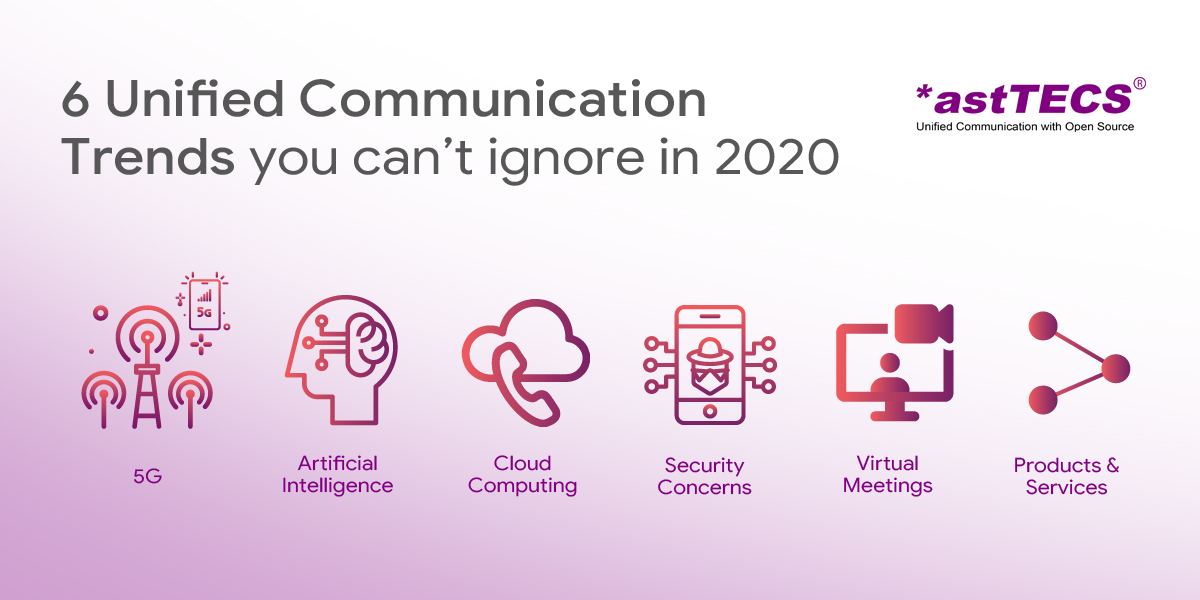Unified Communication Trends in 2020
Not so long ago, artificial intelligence, video-enabled devices and virtual assistants were ambitious concepts edging on the ridiculous. But today, unified communication has been enabled with these technologies. Adopting unified communication trends are top priorities for business owners in 2020.
When it comes to business communication it is important for businesses to adopt the latest technologies to be ahead of the curve. For example, if you are not wowing customers with omnichannel engagement then you are falling behind the curve.
Now, business communication is all about collaboration, customer experience and, remote intelligent communications.
If you are still banging your head about technology shifts in 2019, then 2020 will be even more disruptive. And it’s not just technology that is changing the game but also the customer expectation.
Here are some important unified communication trends business owners should look upon to be ahead of the competition:
Artificial Intelligence
Artificial intelligence is changing the face of Unified Communication so swiftly that Gartner analyst predicted that by 2020, AI technologies would be pervasive in almost every industry.
Today, Voice AI has become the heart of most households and we have been using this technology for everything from controlling the television to switching off the lights. Now, the same technology is creeping into business communication landscape, helping businesses control their meeting room technology, communicating with remote workforce and access to virtual assistants on the go.
Artificial intelligence-based virtual assistants are making their way into the business realm, A virtual assistant can listen to customers call using natural language processing, and can intelligently route calls to the right agent. Parallelly, the same software can deliver information about customer/ caller to the agent for a better experience. This will help companies to reduce customer wait time and increase the response rate.
Besides all this, Artificial Intelligence has made access to intelligent analytics more commonplace. Companies can see the real-world application of artificial intelligence in collaborative communication, meeting and contact centre analytics. It won’t only impact the historical data but also the real-time data.
Artificial Intelligence ability to quickly analyze data has made it possible to set up smart call centres providing omnichannel experience to the customers. AI has enabled call centres to do sentiment analysis on live customer calls where AI bots learn to understand the emotional state of the caller. Speech Analytics capabilities are very useful for business owners as this makes the interaction of customer care agents with callers more personalized.
Cloud Communication
With all the talk about cloud communications, the reality of cloud communication is clear: it’s more efficient and futuristic. Cloud communication facilitates instant messaging, presence across platforms, video and web conferencing, call recording and most importantly team collaboration.
Unlike on-premise solutions, cloud contact centers are not costly and flexible. Cost and flexibility are the major drivers and the reason why organizations are making a smooth shift from on-premise to cloud. Cloud service will not become obsolete like premise-based solutions.
In 2020, the world will see enterprises taking a major shift to the cloud due to the multifold benefits it provides to the business.
Virtual Meeting Room
Virtual meetings (Video Conferencing) can take the employee experience and productivity to the next level. With the increasing trend of remote workforces and distributed office setup has made companies rethink on their meeting options.
What is a virtual meeting?
A virtual meeting is when people can connect in real-time over internet using integrated audio, video, chats and application tools regardless of their location to share information and data. Virtual meetings are the same as physical meeting, the only difference is instead of having physical addresses it has a virtual address in the form of URL (Uniform Resource Locator).
Benefits of the virtual meeting are multifold and this technology is helping companies big time in reducing travel costs of employees and allowing employees to interact remotely, from anywhere, anytime.
5G Connectivity
In a world gone mad for mobile, 5G connectivity is another gift for mobile users. As expected, 2020 is the dawn of 5G technology and the world will see the impact of 5G over internet connections and speed.
This major technology update will virtually affect all the industries but the telecom industry will see one hundredfold improvement in connectivity and speed.
Adoption of 5G will highly impact video conferencing, virtual and augmented reality and mobile VoIP.
Security Concerns
With the pace of new technology implementation increasing, security concerns have also increased. People are more informed and aware of a data breach, privacy policies, and internet security.
Companies also have to maintain standards in terms of security so that customers can trust brands that their data is safe. Some of the major concerns of customers are data centre vulnerability, messaging encryption, demand spike protection, fraud prevention, security controls, and network flexibility.
In addition, UC vendors will have to prominently display their security standard certificates that will reassure that you take security and privacy seriously.
Related Post: Top 4 VoIP security concerns.
The shift in Focus: Products to Services
The shift of focus from products to services is not only impacting how individuals consume and how businesses operate but it has also impacted the world economy. This astronomical shift in the last few years clearly shows the decline of ownership but the rise of usership.
For example, CD’s and songs download sales continue to sink but the music industry continues to grow at a rapid pace. How? Music subscription accounts for 62% of total music sales revenue. Car global sales are down 2.8% from 2017 after booming for a decade but Uber and Ola seems to be performing fine.
Business communication space is also facing effects of this shifting trend as businesses are shifting their communication solutions from on-premise solutions to the cloud solutions and unified communication is also advancing to the Unified Communication as a Service (UCaaS).
What is UCaas?
UCaaS is abbreviation for Unified Communication as a Service. If we demystify the word “UCaaS”, UC means “Unified Communications” and “aas” means “as a service”. Unified communication as a service eliminates the need for customer-premise equipment and lets you run the business on the cloud. It allows businesses to work from anywhere and anytime.
With UCaaS penetrating the industry, now enterprises don’t have to buy bulky IT products and set up servers in their office. Cloud can take care of these for free.
UCaaS technology has elevated to a level that now call centers can also be set up on mobile with zero infrastructure. Mobile Call Center allows monitoring the employees and view reports from a mobile device.
UCaaS allows the mobility and flexibility across work and departments and seamlessly unifies other solutions. As enterprises are adopting the culture of remote employees, UCaaS makes it easy for them to manage employees remotely through solutions such as video and audio conferences, virtual meeting rooms.
It also helps you to stay efficient by managing your remote workforce meeting from a meeting tracker application. The technology has made work so convenient that mobile applications can be used to track meeting, set up a mobile call centre and application can act as a single source of information from mobile, desk phone, and desktop.
Businesses taking a shift from Customer Premise Equipment to Unified Communication as a Service in 2020 will be able to save a lot on their communication costs and accelerate growth, getting an edge over their competitors.
If you have the intention to remain competitive in this technical shifting landscape, then implementing new technologies becomes more critical.
Wrapping Up
So there you have it – the 6 Unified Communication trends one cannot ignore in 2020.
As the decade starts unified communications technology is dipping its toes in more advanced and rapid developments.
John F. Kennedy once said: “Change is the law of life. And those who look only to the past or present are certain to miss the future.”
For anyone in enterprise communications space, keeping pace with technology shifts is an integral part of the job. You must keep looking ahead and strive to embrace new technologies that unified communications has to offer in order to gain an edge over your competitors.




Leave A Comment